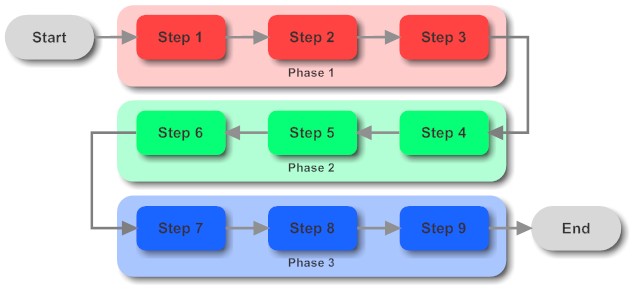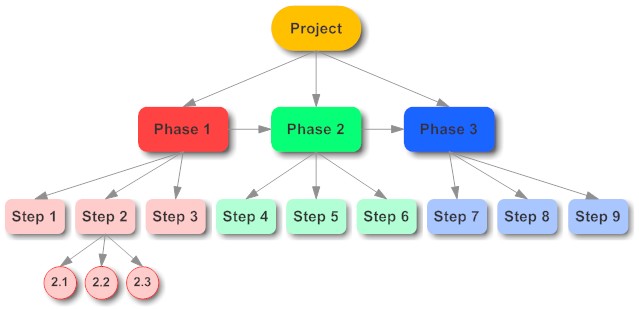Hierarchies, relations and tags - thoughts on thought processes
After the German leg of my 2012 LCTY tour I spent Saturday afternoon with my old friend Siegfried Stadler CEO of HyperSkill in Munich, Germany. We share the curiosity about "what makes humans tick" and had a good chat on perception and communication patterns.
Perception forms reality and when the perception patterns of people don't match, they have a hard time understanding each other. Two prominent patterns I would call Darwin and Newton (note: that's the name I gave them, not a commonly accepted classification). The Newton pattern is the simple " cause - effect" pattern (like the apple hitting Isaac on his head) while the Darwin pattern is a hierarchical structure of one's perception. The differences can be very subtle but create quite warped conversations. Let's look at the example of a project:

For a linear thinker a project is a sequence of steps that follow on equal footing each other. The project phase is just an attribute of an individual step and doesn't require a separate consideration. Attention is on detail and continuous flow of steps. Everything is organised in sequences of start and end, cause and effect.

For a hierarchical thinker a project contains a series of phases that are assembled from a series of steps. The steps are just properties of a phase and need to be vetted in relation to their phase. Attention is on the overall composition of the individual parts. Everything is structured in qualified relations like "is part of", "has details".
Both patterns are valuable and valid. However when they are only implicit they can lead to confusion in collaboration and things get really complicated especially when you insist on your pattern to be "the one and only". Giving them a name allows to communicate about them (that's what some communicators call meta communication - talk about how to talk). So you can ask: " Are we talking Newton or Darwin here"? So what's your primary pattern? Talk about the big picture ore jump into the nitty gritty? Of course there is a third pattern: Talking about the big picture without a clue - usually to be found during popular games in large conventions.
Each of the pattern leads to different preferences for tools and techniques. Linear thinking favours list and tags, while hierarchical thinking favours mindmaps and taxonomies. I'm gravitating towards hierarchies, but find them difficult to agree on (there is debate even for the hierarchy of species) once a group that needs to use them gets larger.
An interesting observation in the use of relations by linear thinkers (which first were simple "tags") is the appearance of qualification (hierarchy can be seen as one form of qualification of a relation). Early on Facebook only had one relation: friend. Now there is "follows" and "is followed" which is already some kind of hierarchy, besides the family relation category (son of, father of). The question might be: when to use what?
So what are you, a Darwin or a Newton?
Perception forms reality and when the perception patterns of people don't match, they have a hard time understanding each other. Two prominent patterns I would call Darwin and Newton (note: that's the name I gave them, not a commonly accepted classification). The Newton pattern is the simple " cause - effect" pattern (like the apple hitting Isaac on his head) while the Darwin pattern is a hierarchical structure of one's perception. The differences can be very subtle but create quite warped conversations. Let's look at the example of a project:

For a linear thinker a project is a sequence of steps that follow on equal footing each other. The project phase is just an attribute of an individual step and doesn't require a separate consideration. Attention is on detail and continuous flow of steps. Everything is organised in sequences of start and end, cause and effect.

For a hierarchical thinker a project contains a series of phases that are assembled from a series of steps. The steps are just properties of a phase and need to be vetted in relation to their phase. Attention is on the overall composition of the individual parts. Everything is structured in qualified relations like "is part of", "has details".
Both patterns are valuable and valid. However when they are only implicit they can lead to confusion in collaboration and things get really complicated especially when you insist on your pattern to be "the one and only". Giving them a name allows to communicate about them (that's what some communicators call meta communication - talk about how to talk). So you can ask: " Are we talking Newton or Darwin here"? So what's your primary pattern? Talk about the big picture ore jump into the nitty gritty? Of course there is a third pattern: Talking about the big picture without a clue - usually to be found during popular games in large conventions.
Each of the pattern leads to different preferences for tools and techniques. Linear thinking favours list and tags, while hierarchical thinking favours mindmaps and taxonomies. I'm gravitating towards hierarchies, but find them difficult to agree on (there is debate even for the hierarchy of species) once a group that needs to use them gets larger.
An interesting observation in the use of relations by linear thinkers (which first were simple "tags") is the appearance of qualification (hierarchy can be seen as one form of qualification of a relation). Early on Facebook only had one relation: friend. Now there is "follows" and "is followed" which is already some kind of hierarchy, besides the family relation category (son of, father of). The question might be: when to use what?
So what are you, a Darwin or a Newton?
Posted by Stephan H Wissel on 11 February 2012 | Comments (1) | categories: After hours